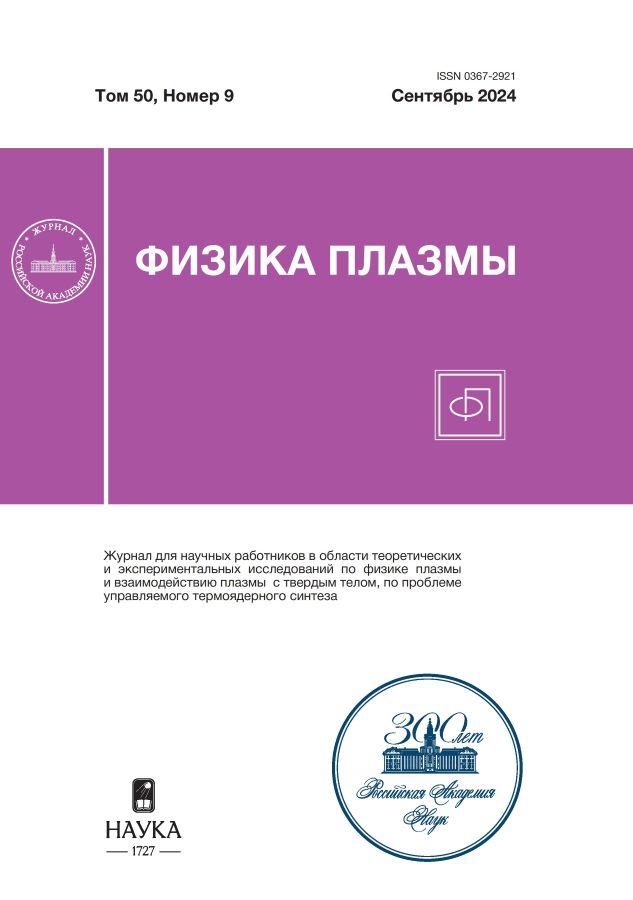Method for Measuring the Plasma Temperature at the GOL-NB Facility
- Authors: Polosatkin S.V.1,2,3, Pavlova G.S.4
-
Affiliations:
- Budker Institute of Nuclear Physics, Siberian Branch, Russian Academy of Sciences
- Novosibirsk State Technical University
- Novosibirsk State University
- Private Institution Project Сenter ITER
- Issue: Vol 50, No 9 (2024)
- Pages: 1116-1123
- Section: PLASMA DIAGNOSTICS
- URL: https://cardiosomatics.ru/0367-2921/article/view/683721
- DOI: https://doi.org/10.31857/S0367292124090076
- EDN: https://elibrary.ru/DVCDKI
- ID: 683721
Cite item
Abstract
A new method is proposed for measuring the electron plasma temperature at the GOL-NB facility.The method is based on measuring the ratio between the intensities of the spectral lines emitted by the fastatoms injected into the plasma. The beams of fast hydrogen atoms used for heating the plasma at the GOLNBfacility contain not only atoms with a full energy (E) but also atoms with fractional energies (E/2, E/3,E/18) that appear as a result of the dissociation of the H2+, H3+, and H2O+ molecular ions. The spectral linesof the beam components with these energies (and, in particular, the hydrogen Hα line) can be resolved dueto the Doppler shift caused by the difference between the atom speeds. For atoms with low energy, the excitationthat leads to the photon emission occurs only due to their collisions with thermal electrons, while foratoms with high energy, a sufficient deposition into their excitation is given by their collisions with the plasmaions. This is why the ratio between the intensities of the lines of different beam components depends on theplasma electron temperature, and thus, it can be used to measure this temperature. At the beam energy of24 keV, the proposed method can be used to measure the electron temperature in the range of up to 40 eV,which is of interest for the current experiments conducted at the GOL-NB facility. Note that measurementof the electron temperature higher than 20 eV requires that the ratio between the spectral line intensities bemeasured with an accuracy of the order of one percent, and that the attenuation of the neutral beam thatpasses through the plasma be measured with the same accuracy. The proposed method can be used at otherfusion facilities that use fast hydrogen atom injection to measure the temperature of the edge plasma.
Keywords
Full Text
About the authors
S. V. Polosatkin
Budker Institute of Nuclear Physics, Siberian Branch, Russian Academy of Sciences; Novosibirsk State Technical University; Novosibirsk State University
Author for correspondence.
Email: s.v.polosatkin@inp.nsk.su
Russian Federation, Novosibirsk, 630090; Novosibirsk, 630073; Novosibirsk, 630090
G. S. Pavlova
Private Institution Project Сenter ITER
Email: G.Pavlova@iterrf.ru
Russian Federation, Moscow, 123098
References
- Postupaev V.V., Batkin V.I., Burdakov A.V., Burmasov V.S., Ivanov I.A., Kuklin K.N., Lykova Yu.A., Melnikov N.A., Mekler K.I., Nikishin A.V. // Nuclear Fusion. 2022. V. 62. P. 086003. doi: 10.1088/1741-4326/ac69fa.
- Batkin V.I., Bambutsa E.E., Burdakov A.V., Burmasov V.S., Gafarov M.R., Voskoboinikov R.V. // AIP Confer. Proceed. 2016. V. 1771. P. 030010. doi: 10.1063/1.4964166.
- Поступаев В.В., Юров Д.В. // Физика плазмы. 2016. Т. 42. С. 966. doi: 10.7868/S036729211611007X.
- Sidorov E.N., Batkin V.I., Burdakov A.V., Ivanov I.A., Kuklin K.N., Mekler K.I., Nikishin A.V., Postupaev V.V., Rovenskikh A.F. // J. Instrumentation. 2021. V. 16. P. T11006. doi: 10.1088/1748-0221/16/11/T11006.
- Uhlemann R., Hemsworth R.S., Wang G., Euringer H. // Rev. Sci. Instrum. 1993. V. 64. P. 974. doi: 10.1063/1.1144100.
- Ivanov A.A., Deichuli P.P., Kreter A., Maximov V.V., Schweer B., Shikhovtsev I.V., Stupishin N.V., Usoltsev D.V., Podminogin A.A., Uhlemann R. // Rev. Sci. Instrum. 2004. V. 75. P. 1822. doi: 10.1063/1.1699508.
- Geiger B., Stagner L., Heidbrink W.W., Dux R., Fischer R., Fujiwara Y., Garcia A.V., Jacobsen A.S., Vuuren A.J., Karpushov A.N., Liu D., Schneider P.A., Sfiligoi I., Poloskei P.Zs., Weiland M. // Plasma Phys. Control. Fusion. 2020. V. 62. P. 105008. doi: 10.1088/1361-6587/aba8d7.
- Polosatkin S. // J. Instrumentation. 2013. V. 8. P. 05007. doi: 10.1088/1748-0221/8/05/P05007.
- Polosatkin S.V., Ivanov A.A., Listopad A.A., Shikhovtsev I.V. // Rev. Sci. Instrum. 2014. V. 85. P. 02A707. doi: 10.1063/1.4826339.
- Barnett C. Atomic Data for Fusion. Vol. 1: Collisions of H, H2, He, and Li atoms and ions with atoms and molecules. ORNL-6086/VI Report. 1990.
- Beklemishev A.D., Bagryansky P.A., Chaschin M.S.,Soldatkina E.I. // Fusion Sci. Technology. 2010. V. 57. P. 351. doi: 10.13182/FST10-A9497.
Supplementary files
















